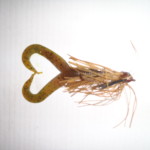Call it a tale of two Sinclairs. Or a tale of three lakes in only three days. Last weekend showed how fast bass fishing can change this time of year.
Last Friday I met Ricky Layton to get information for my GON April Map of the Month article. The weather guessers were right for a change when they predicted high winds, bluebird skies and cold weather. That combination is usually the kiss of death for fishing in the spring.
Ricky said we would meet at Bass’s Boat House, an old marina where the clubs used to put in back in the 1970s. It was near the dam and the water might be slightly clearer in that area, and we would be more protected from the wind. All this spring the flooding rains have made our lakes fill up with very muddy water.
We waited until 9:00 AM to go out since it was cold. The first two hours seemed to show the weather and muddy water was working against us. Ricky took me to some places he had caught good fish the weekend before, but the water was even muddier than it had been and we got no bites.
At 11:00 Ricky was starting to look at the article pattern and caught an eight-pound largemouth on a bladed jig. The fish was up shallow near a grass bed, the pattern for April. That is a big fish for Sinclair, it has been a long time since I have seen one that big there, although there have been several that were close the past few years.
About noon we started fishing and marking places for the article, working bass bedding and shad spawning areas. Ricky caught a five-pound largemouth out of a grass bed on what will be hole #2. A few minutes later he caught one weighing about six pounds there.
The next place we fished Ricky caught another fish right at six pounds, on the same pattern, halfway back in a creek with grass beds up shallow on the bank. One of the last places we fished he landed his smallest fish of the day, one that weighted about 3.5 pounds. In all that time I landed one weighing about 2.5 pounds, but my excuse is I was too busy netting his fish and taking pictures and notes to fish.
Ricky ended up with five bass weighing a conservative 28 pounds. That is the kind of catch you dream about and expect on Guntersville, not Sinclair, especially under bad weather conditions. The water temperature was 58 to 59 degrees where we fished, making those big largemouth were looking for bedding areas.
On Saturday Ricky took his son fishing at Sinclair. Although colder, the weather was better, but the fishing was not. He said they did land a seven-pound fish out of hole #10 but their best five weighed “only” about 14 pounds, not great compared to the day before.
I could not wait to get on the water Sunday morning in the Flint River Bass Club March tournament at Sinclair. I should have known better.
After fishing from 8:00 AM to 4:00 PM, 13 members landed 20 bass weighing about 36 pounds. There was one five bass limit and five people didn’t catch a 12-inch keeper.
Travis Weatherly won with five weighing 9.02 pounds and his 4.99 pound largemouth was big fish. My three weighing 7.47 placed second and I had a 4.57 pounder for my biggest fish. Niles Murray placed third with three weighing 5.75 pounds and Brent Drake came in fourth with three weighing 4.20 pounds.
The cold air made me shiver on my run to my first stop. Luckily there was enough wind to keep the fog down, it was wispy and hanging just off the water. But there was enough to make it scary trying to watch for all the floating wood.
I stopped off a grass bed that was perfect for the pattern Ricky caught his big fish on Friday, but my heart sank when my temperature gauge hit 49 degrees. A nine or ten degree drop just had to affect the bass. It surely did affect my optimism!
I fished three places in three hours without a bite. Around 11:00 the weak sun was warming the water a little, raising the temperature to about 51 degrees in the cove where Ricky caught a six pounder. I cast a Chatterbait across in front of a grass bed, something thumped it and I set the hook.
My rod bowed up and the fish headed for deep water. I just knew I had a six pounder on, but suddenly my line went slack. The fish just pulled off without me ever seeing it.
At noon I was in the area where Ricky caught two fish, hole #2. I was very down, fishing half the day without a keeper. The water had warmed to 52 so I had some hope. I cast my Chatterbait into some grass and hooked the four pounder I weighed in. That improved my attitude a lot.
After another hour of fishing without a bite, I caught a two pounder in front of some grass, then at 2:00 PM landed my third keeper, a one pounder, from another grass bed. That was it. I fished hard for the rest of the day without another bite.





